A comprehensive assessment helps identify underlying causes of infertility and guides personalized treatment plans. Female infertility is diagnosed through medical history, physical exams, ovulation monitoring, hormone testing, ovarian reserve assessment, imaging tests like HSG, and sometimes laparoscopy or genetic testing for precise diagnosis and treatment planning.
- Medical History: The doctor reviews the patient's medical history, menstrual cycles, past pregnancies, and any relevant health issues.
- Physical Examination: A pelvic exam checks for abnormalities in the reproductive organs, such as fibroids or endometriosis.
- Ovulation Monitoring: Ovulation is tracked through methods like basal body temperature charting, ovulation predictor kits, or ultrasound monitoring.
- Hormone Testing: Blood tests measure hormone levels to assess ovulation, ovarian reserve, and thyroid function.
- Ovarian Reserve Testing: This includes tests like AMH (Anti-Müllerian Hormone) levels and antral follicle count to evaluate egg quantity and quality.
- Hysterosalpingography (HSG): An X-ray procedure examines the uterus and fallopian tubes for blockages or abnormalities.
- Sonohysterogram: This ultrasound-based test assesses the uterine cavity for abnormalities.
- Laparoscopy: Invasive surgery may be used to diagnose conditions like endometriosis or pelvic adhesions.
- Genetic Testing: Chromosomal abnormalities or genetic factors may be evaluated through genetic testing.
- Other Tests: Additional tests may include checking for infections, immune system disorders, or factors affecting cervical mucus quality.




.png)

Comments